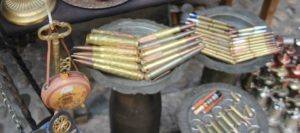I thought it only right that I follow my blog entry about the Bosnian drink of choice, with a post about the Bosnian food of choice: ćevapi. It is hard to describe it, so I will start by providing a picture:

This picture was taken at a restaurant in old town named Želo. While very few would dispute the fact that this restaurant provides the best ćevapi, some in the city refuse to eat here because the name is a reference to one of the local football clubs. Želo’s inter-city rivals are called Sarajevo, and their official restaurant is one street over. So if you ever find yourself in Sarajevo, do yourself a favor and eat at the restaurant with the blue football logo above the entrance. When the waiter arrives say “monge ćevapi pet sa kaymak i Keiselya (or češe voda).” You are ordering a small portion of ćevapi— I promise it will be enough— with cream and sparkling water (or still if you prefer).
To be 100% honest, I am not actually sure what all of the constituent parts of this dish are. But, everyone that I have asked has given me the same description, and for that reason I will pass it on to you. The bread is a special kind of circular bread, and it is freshly baked every day at the restaurant. This specific type of loaf is called “solmud,” and it particularly popular during the month of Ramadan. During that month it is served with special types of cheese dip at nearly every evening meal breaking the fast. No one has yet been able to tell me what kind of meat is served in the bread, though I have been told that it is minced meat. The cream looks like butter, but has neither its flavor nor consistency. When I asked how it was made, I was told that it is essentially the fat that is skimmed off the top of milk as it is being churned. Additional spices are added, though no one could tell me what they are. The dish is served with a side of raw onion.
A few street over from the restaurant, also in old town, you will find copper alley. It is a street names for artisans who work in its small shops. As a city between the Ottoman empire and western Europe, Sarajevo has represented an important link between east and west for centuries. One of the ways this significance has been expressed is by the number of local merchants and artisans. While increasing industrialization and modernization has dramatically reduced the number of skilled craftsman, in silver alley you can still find skill artisans practicing their craft in the traditional way. These artisans take copper, silver, and copper-plated materials and— using a small chisel— carve elaborate designs into them. In copper alley you can find everything from traditional coffee pots and cups, to jewelry, to elaborately engraved bullets. The following pictures shows an example of some of the copper war relics that can be purchased there.

No trip to Sarajevo would be complete without a meal at Želo and a stroll down copper alley.